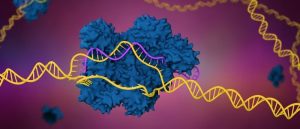CRISPR gene editing: in summary
What is CRISPR gene editing?
CRISPR gene editing technologies enable changes to be made to DNA at specific regions. These changes can involve DNA insertion or deletion, or base pair disruption and can lead to gene activation or inactivation. The first CRISPR – or clustered regularly interspaced short palindromic repeats – system to be used for gene editing was CRISPR/Cas9. There are now a number of different CRISPR systems used for gene editing purposes, with researchers continually developing new and improved systems for a multitude of different applications.
How does CRISPR gene editing work?
The CRISPR/Cas9 system is the most often used. When CRISPR/Cas9 is added to a cell along with a guide RNA (gRNA) molecule, the Cas9 enzyme binds to the gRNA, which is about 20 bases long and designed to be complementary to the target sequence within the DNA to be edited. The gRNA will also bind to the complementary region of DNA, and Cas9 will then cut the DNA at the desired target. The cell then recognizes that the DNA is damaged and tries to repair it.
During this repair process, alterations to the DNA sequence are introduced. In the case of Cas9, these mutations often disable a gene. Other enzymes can also be used that lead to different outcomes, including Cas12a. CRISPRi and CRISPRa use customized Cas proteins that do not cut or alter DNA but can turn genes on or off.
The history of CRISPR gene editing
The 2020 Nobel Prize in Chemistry was awarded to Jennifer Doudna and Emmanuelle Charpentier for the development of CRISPR gene editing. CRISPR/Cas9 was first isolated and leveraged to cut specific sites in DNA by the pair in a paper published in 2012, titled ‘A programmable dual-RNA-guided DNA endonuclease in adaptive bacterial immunity.‘
Since the CRISPR/Cas9 system was first used in this way by Doudna and Charpentier, the popularity of CRISPR has skyrocketed, with many different applications in science and medicine. Some notable uses of CRISPR over the last decade include He Jiankui’s controversial CRISPR gene-edited babies in 2018; a Phase I clinical trial showing successful, safe CRISPR gene editing in three cancer patients in 2020; and the first clinical trial of intravenous CRISPR gene editing in humans concluding in June 2021.
CRISPR has enabled genomic editing to be more accessible, with reduced costs and time associated, compared to alternative gene-editing methods. Looking to the future, the potential applications of CRISPR gene editing appear endless, with the tool showing promise in drug screening, agriculture, diagnostics and therapeutics, to name but a few.
Featured
CRISPR is a key element of many lab scientists’ toolkits. In addition to its application in basic research, CRISPR is also being applied as a diagnostic and therapeutic tool, and is generating invaluable insights for drug discovery.
What are off-target effects of CRISPR and why are they concerning?
Gaetan Burgio of the Australian National University (Canberra, Australia) discusses the off-target effects of CRISPR, how they occur, how to avoid them and their impacts on the uses of the technique.
 Talking Techniques | CRISPR: developing an equitable technology amidst a global pandemic
Talking Techniques | CRISPR: developing an equitable technology amidst a global pandemic
In this episode, Geoffrey Siwo speaks about CRISPR and the challenges facing its development into a technique that can be applied equitably across the globe.
Making CRISPR gene editing safer for therapeutic applications
Researchers have discovered a Cas9 mutant that increases the fidelity of CRISPR editing and avoids off-target hits.

